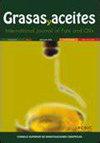不同提取方法对藏红花抗氧化活性、总酚和番红花苷含量的影响以及藏红花提取物对常见植物油氧化稳定性的保护作用
IF 1.1
4区 农林科学
Q4 CHEMISTRY, APPLIED
引用次数: 1
摘要
藏红花由具有促进健康特性的生物活性化合物组成,主要用于医药、调味和着色。在本研究中,我们旨在研究提取方法对藏红花提取物(SE)抗氧化活性的影响,并评估SE在植物油中的抗氧化性能。使用浸渍提取(ME)、超声辅助提取(UAE)、微波辅助提取(MAE)以及UAE与MAE的组合在水、乙醇、甲醇及其组合中提取藏红花柱头。结果表明,用甲醇/水(50:50)萃取的样品,采用UAE和MAE相结合的方法,总酚含量(31.56mg/gGAE)和抗氧化活性(83.24%的抑制作用)最高。具有最高抗氧化活性的提取物在掺入油样品之前被冷冻干燥。冻干SE含有反式-rocin-4和反式-procin-3(最丰富的成分)、山奈酚和苦罗素。此外,添加1000ppm的SE导致油菜籽(CAO)、向日葵(SO)和玉米油(COO)的氧化稳定性显著提高。本文章由计算机程序翻译,如有差异,请以英文原文为准。
Effect of different extraction methods on saffron antioxidant activity, total phenolic and crocin contents and the protective effect of saffron extract on the oxidative stability of common vegetable oils
Saffron consists of bioactive compounds with health-promoting properties and is mainly used in medicine, flavoring and coloring. In this study, we aimed to investigate the effect of extraction methods on the antioxidant activity of saffron (Crocus sativus L.) extracts (SE) and to evaluate the antioxidant performance of SE in vegetable oils. Saffron stigmas were extracted in water, ethanol, methanol, and their combinations using maceration extraction (ME), ultrasonic-assisted extraction (UAE), microwave-assisted extraction (MAE), and the combination of UAE with MAE. The results showed that the sample extracted by methanol/water (50:50) using the combination of UAE with MAE methods had the highest amount of total phenolic content (31.56 mg/g GAE) and antioxidant activity (83.24% inhibition). The extract with the highest antioxidant activity was freeze-dried before incorporation into oil samples. Freeze-dried SE contained trans-crocin-4 and trans-crocin-3 (most abundant constituents), kaempferol, and picrocrocin. Moreover, the addition of SE at 1000 ppm resulted in a significant increase in the oxidative stability of canola (CAO), sunflower (SO), and corn oil (COO).
求助全文
通过发布文献求助,成功后即可免费获取论文全文。
去求助
来源期刊

Grasas y Aceites
工程技术-食品科技
CiteScore
2.50
自引率
0.00%
发文量
50
审稿时长
3 months
期刊介绍:
Grasas y Aceites is a peer-reviewed journal devoted to the publication of original articles concerning the broad field of lipids, especially edible fats and oils from different origins, including non acyl lipids from microbial origin relevant to the food industry. It publishes full research articles, research notes, reviews as well as information on references, patents, and books.
Grasas y Aceites publishes original articles on basic or practical research, as well as review articles on lipid related topics in food science and technology, biology, (bio)chemistry, medical science, nutrition, (bio)technology, processing and engineering. Topics at the interface of basic research and applications are encouraged. Manuscripts related to by-products from the oil industry and the handling and treatment of the wastewaters are also welcomed.
Topics of special interest to Grasas y Aceites are:
-Lipid analysis, including sensory analysis
-Oleochemistry, including lipase modified lipids
-Biochemistry and molecular biology of lipids, including genetically modified oil crops and micro-organisms
-Lipids in health and disease, including functional foods and clinical studies
-Technical aspects of oil extraction and refining
-Processing and storage of oleaginous fruit, especially olive pickling
-Agricultural practices in oil crops, when affecting oil yield or quality
 求助内容:
求助内容: 应助结果提醒方式:
应助结果提醒方式:


